American Shad On The Delaware River
Savoring the shad run in the Delaware River with shad darts and flutter spoons.
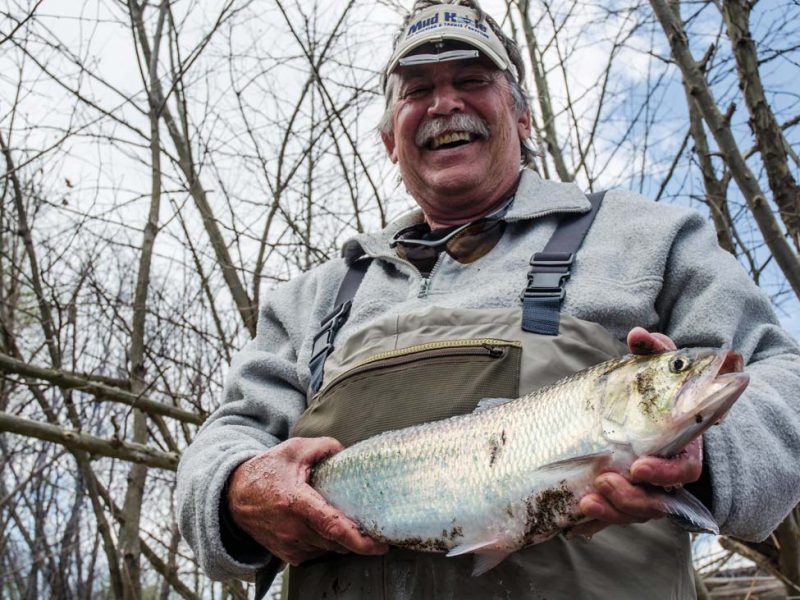
In large, hastily written red letters—underneath the plaque celebrating the return of the American shad to the Lehigh River—the graffiti poses an imposing question. Would you make it?
The American shad, like the rivers they run, have had it rough since the industrial revolution. We’ve fished them out in immense numbers, blocked their passage with dams, and polluted their spawning grounds.
Even without our interference, each individual shad faces a momentous set of challenges. First, it must survive the river as a juvenile, avoiding smallmouth bass, catfish, and stripers. Then, when the shad heads downriver to the ocean, it grows larger, and so do its predators. After 3 to 5 years at sea, the shad returns to the river, traveling hundreds of river miles past thousands of fishermen, to spawn. So, no, I probably wouldn’t make it.
After looking through the algae-covered glass of the fish passage between the Delaware and the Lehigh rivers, I walk downriver. A few hundred yards from the confluence, a group of fishermen have set up a small camp, replete with a smoldering fire and portable radio tuned to the local classic rock station. The day is warming quickly, and the fishermen have already begun shedding layers, draping jackets over low-hanging limbs and across the logs deposited on the bank by flood conditions earlier in the month. One of them is landing a thrashing shad and I quicken my pace, looking for an open spot in the lineup while the opening chords from Bruce Springsteen’s Glory Days crackle over the radio.
(Note: On The Water is reader-supported. When you buy through links on our site, we may earn an affiliate commission.)
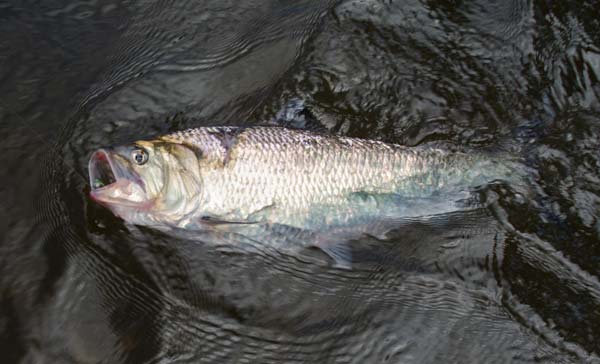
I deliberate over which size and color shad dart to start with. “It probably doesn’t matter,” I mumble to myself, before tying on a trusty ¼-ounce chartreuse-and-green dart. And, why should it? American shad are filter feeders in the ocean, and in the rivers they don’t feed at all. A shad has no reason to strike a dart, but it will—out of aggression, most fishermen agree. Knowing this, details like the color and size of a shad dart should not matter—but they do.
Barry, one of the half-dozen fishermen putting on a shad-catching clinic on that mid-April morning, explains that he matches his darts to the river conditions. High and stained water calls for big and bright darts, low and clear water requires small but still bright darts. The river is running high and a little dirty, but is cleaning up fast. Still, my large chartreuse dart comes up empty drift after drift, while Tony, another shad regular, calls his shots.
“I’m going to get one within the next three casts,” he says in a South Philadelphia accent that seems at odds with the Yankees hat pulled low over his forehead. It takes only two before Tony’s rod bends under the strain of another shad.
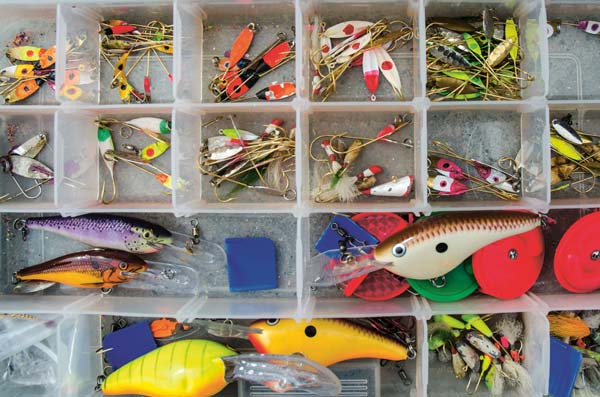
I switch colors, sizes, spots, to no avail. Another fisherman, downstream of Tony and Barry, is struggling as well.
“It could be the weight,” Tony suggested to his friend. “You gotta be near the bottom.”
Though the advice wasn’t directed to me, I take it, clamping a second split shot onto my line.
The same ¼-ounce chartreuse and green shad dart that I’d started with sweeps through the same water where I’d started, but this time, the rod tip wrenches downriver as it nears the end of its drift. The fish fights with wild headshakes and changes of direction, a fight I’ve learned to associate with the smaller male, “buck” shad. The hook pulls just as my split shot breaks the surface and I see the faint outline of a shad through the tea-colored water.
On my next cast, at the same point in the drift, the rod bows over again. This one doesn’t move right away, giving me the momentary impression that I’ve snagged bottom. The snag slowly comes to life, deep tailbeats shaking the rod. My drag, set light to keep from tearing the hook from the paper-thin membrane of the shad’s mouth, begins singing as the fish bolts under the railroad bridge. I take my time, letting the fish control the fight. I slowly begin to gain ground, winning one turn of the reel handle at a time, bowing to the big “roe” shad when she surges.
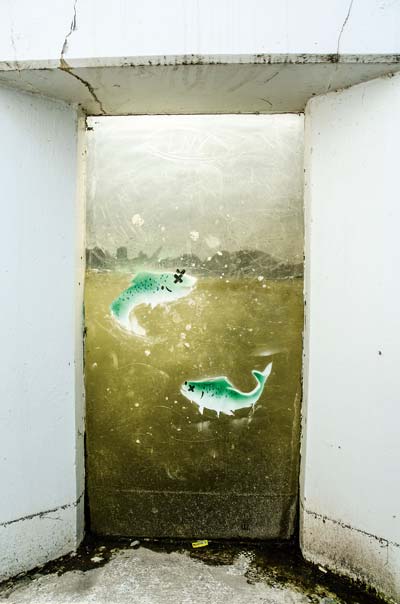
Inch by inch, I work the shad back until she turns broadside to the current, using the whole unbridled force of the longest free-flowing river in the eastern U.S to help her stand her ground. I need to strike a balance between force and finesse to gain line without pulling the hook. Finally, I see her, a gleaming slab of silver, nearly two feet long and wide enough to completely cover my hand when I grab the leader and cradle the fish, just as the dart drops out. The big roe slips out of my grasp before I can ask Barry to take a picture.
I’ve fished shad on four rivers—the Delaware, the Connecticut, the Susquehanna, and a small one, more of a creek, that I’ve been asked not to divulge. The Susquehanna, below the Conowingo Dam, is where I first experienced the fun and ritual of shad fishing. The Susquehanna run consisted mainly of the smaller hickory shad, but every so often, an American shad— “white shad” in the local parlance—grabbed a dart and took an angler for a ride.

The Connecticut River has a more robust run of American shad than the now-struggling Susquehanna, but the undammed main stem of the Delaware River is widely regarded as the best shad river in the Northeast.
Easton is just one of several dozen shad-fishing hotspots on the Delaware River, beginning around Trenton, New Jersey, and extending past the Delaware Water Gap National Recreation Area. My friend Joe Demalderis, a fly-fishing guide on the Upper Delaware, sees shad every year around Hancock, New York, where some of his clients sight-cast to them with brightly colored “shad dart flies.”
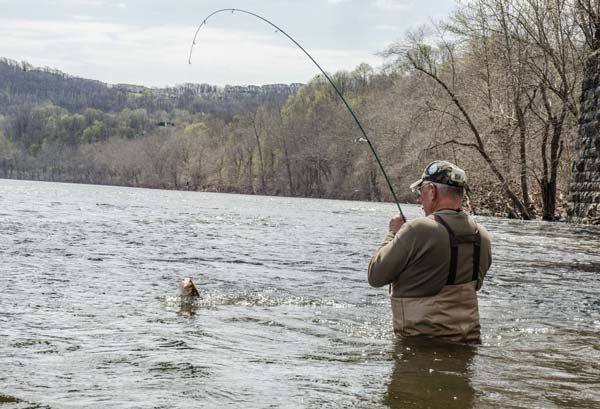
Fishermen catch the first shad sometime in March, and, if you are so inclined, you can follow the run upriver and continue catching shad through June. I overheard Tony, the Yankee-hat-wearing shad sharpie, mention that he stops shad fishing around Memorial Day, when he believes the warm water leads to a higher release mortality.
While most shad are released, some are taken home to eat. The old nickname for shad, “poor man’s salmon,” refers to the shad’s penchant for running upriver and leaping when hooked, and to its food quality. That last part seems highly subjective, at least based on my experience. I took my first bite of shad at the Lambertville, New Jersey Shad Festival in 2015 and couldn’t bring myself to take a second.
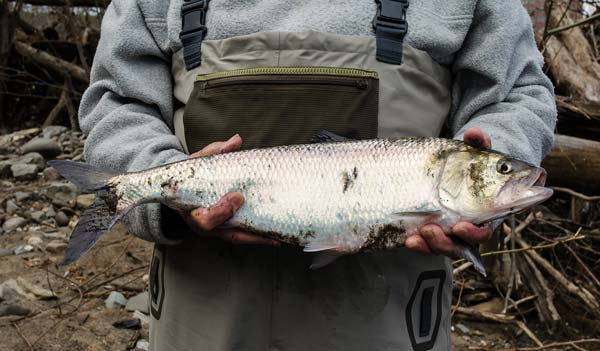
Yet, I might be missing out. The American shad’s scientific name, Alosa sapidissima, suggests that whoever named the fish found it palatable enough to use the Latin word for “most savory.” And, to be fair, the slab of shad grilled quickly, slathered with tartar sauce, and slapped on a bun was offered to the festival-goers more as a novelty than an entrée.
After adding the split shot, I begin holding my own with the other fishermen working the pool, and for a while, I have the hot hand.
Shad move upriver in specific “lanes,” following a current seam or underwater structure, so getting your dart into that lane as much as possible is the ticket to putting shad on the bank. Boat fishermen jockey for the prime positions, anchoring up and setting a wide spread of rods to give themselves the best odds of putting a lure in the middle of a shad highway. When swinging darts from shore, finding the lane requires varying casting distance, how far upstream or downstream you cast, and where you’re standing.
For about 30 minutes I am in the zone, casting at 1 o’clock, letting the dart sink for a couple seconds before closing the bail and letting it swing on a tight line. Every cast gets hit. One shad breaks my 8-pound leader on the strike, another bends my hook, but plenty come to hand, big gleaming slabs of silver. Most of them take line, some of them leap, and every one puts a serious bend into the 9-foot noodle rod.
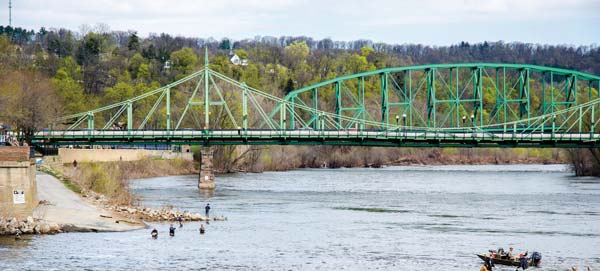
Thumbnail-sized scales begin accumulating on my waders, but rough handling isn’t entirely to blame. A shad’s loose scales are an evolutionary adaptation that allow the fish greater mobility when swimming such long distances. That mobility is apparent when fighting a hooked shad—the fish’s tail never stops beating.
It’s nearly 3pm when the buzzing of my phone from deep within my waders breaks the reverie of cast-swing-repeat. It’s my wife, Pam, wondering why my “morning” fishing trip has lasted well into the afternoon. She reminds me that my outing has run a little long and we have dinner plans with my aunt in Philadelphia.
With effort, I pull away from the river after making nearly a dozen “last casts.” The fishing has slowed down to a steady pick, but Tony suggests it could pick back up as evening approaches. I won’t be there to find out. I retrieve my jacket from a branch and break down the rod before exchanging contact information with Barry. “Let me know next time you’re in town,” he says, “I’ll let you know if they’re running.”
I take a long look at the river from the parking lot and see a fisherman in a boat net a shad. For now, at least, it looks like the Delaware River shad have made it. They’ll be running next spring, and the spring after, and knowing that makes it easier to get into the car and drive away. I arrive at dinner smelling of shad, but otherwise on time.
Related Content
6 on “American Shad On The Delaware River”
-
Thomas Dietrich Would like to give this a try. Is there a site that posts where the shad are on the Delaware @ any particular time. I’m about 75 mi. east of the water gap.
Thanks-
John Augustine Thomas, the Delaware is full of them right now. There are several Facebook sites, just search American Shad, Delaware Shad, Shad Fishing Reports. Right now Riegelsville to Port Jervis is loaded. You can email me anytime and I can steer you onto them.
-
-
Cenk Öztürk I love this fish …
-
Thomas Dietrich Thanks. Please keep me posted.
-
Thomas Dietrich Thanks. Please keep me posted.
-
Jeff Hafer Nothing like it. I’ve been fishing for them over 30 years.
Leave a Reply